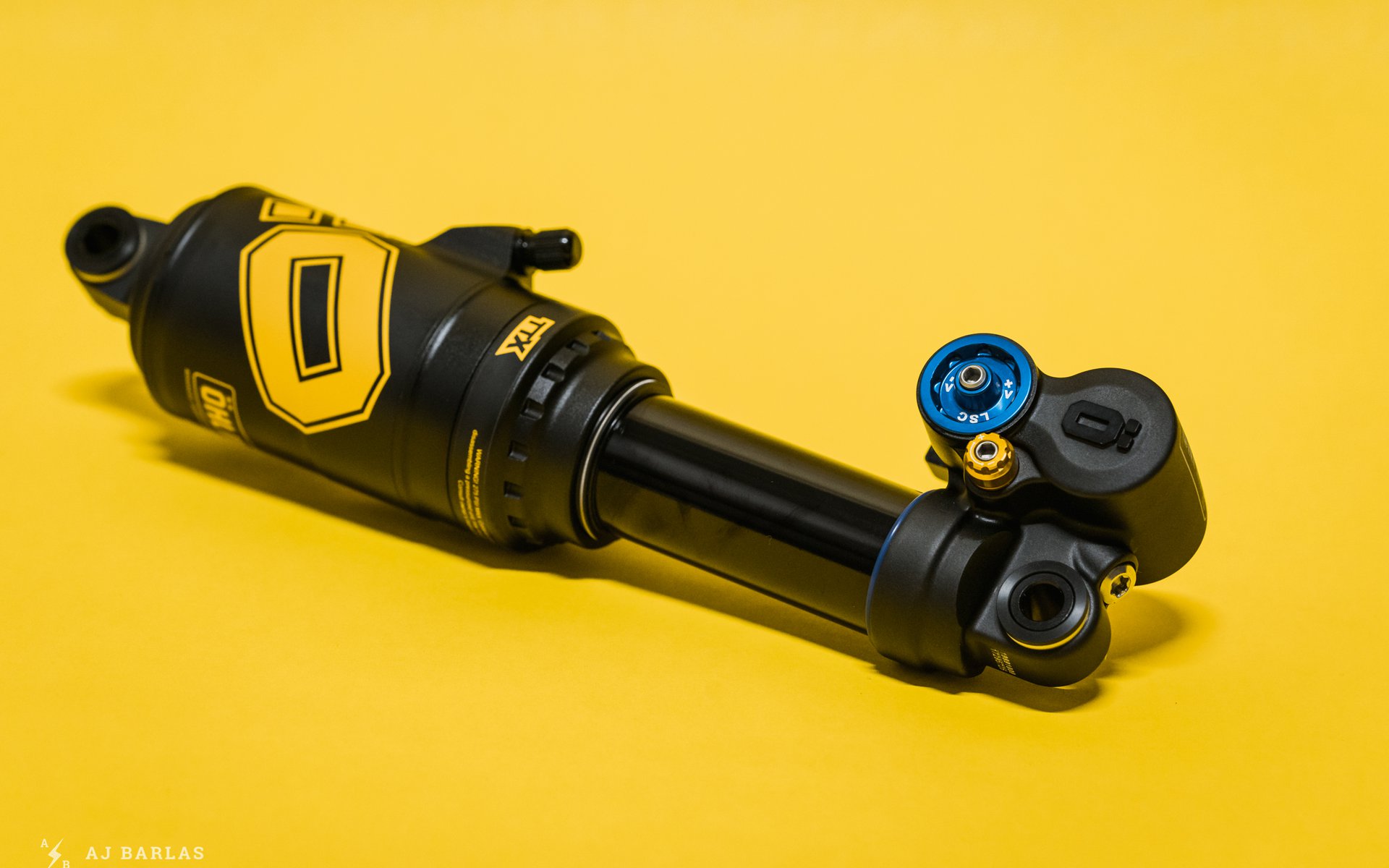
Long Term Thrashing
2020 Öhlins TTX Air & RXF36 m.2 Air Review
When Öhlins released the latest RXF forks they also unveiled their revitalized air shock. The TTX Air is ‘born out of the highly successful TTX22M Coil’ shock, giving it heaps to live up to. The shock uses the 22mm twin tube damper found in the coil shock, also offering the limited external adjustability of the HSC (2 positions with the 3rd being a pedal-assist) while providing 12 clicks of LSC and 12 clicks of rebound.
Highlights
- TTX22 Damper Technology
- Modular reducer system
- Metric and Trunnion sizes
- Air spring fully serviceable w/o opening damper
- Weight: 524g (230x65 full of spacers w/ hardware)
- MSRP: 780 USD/733.20 Euro
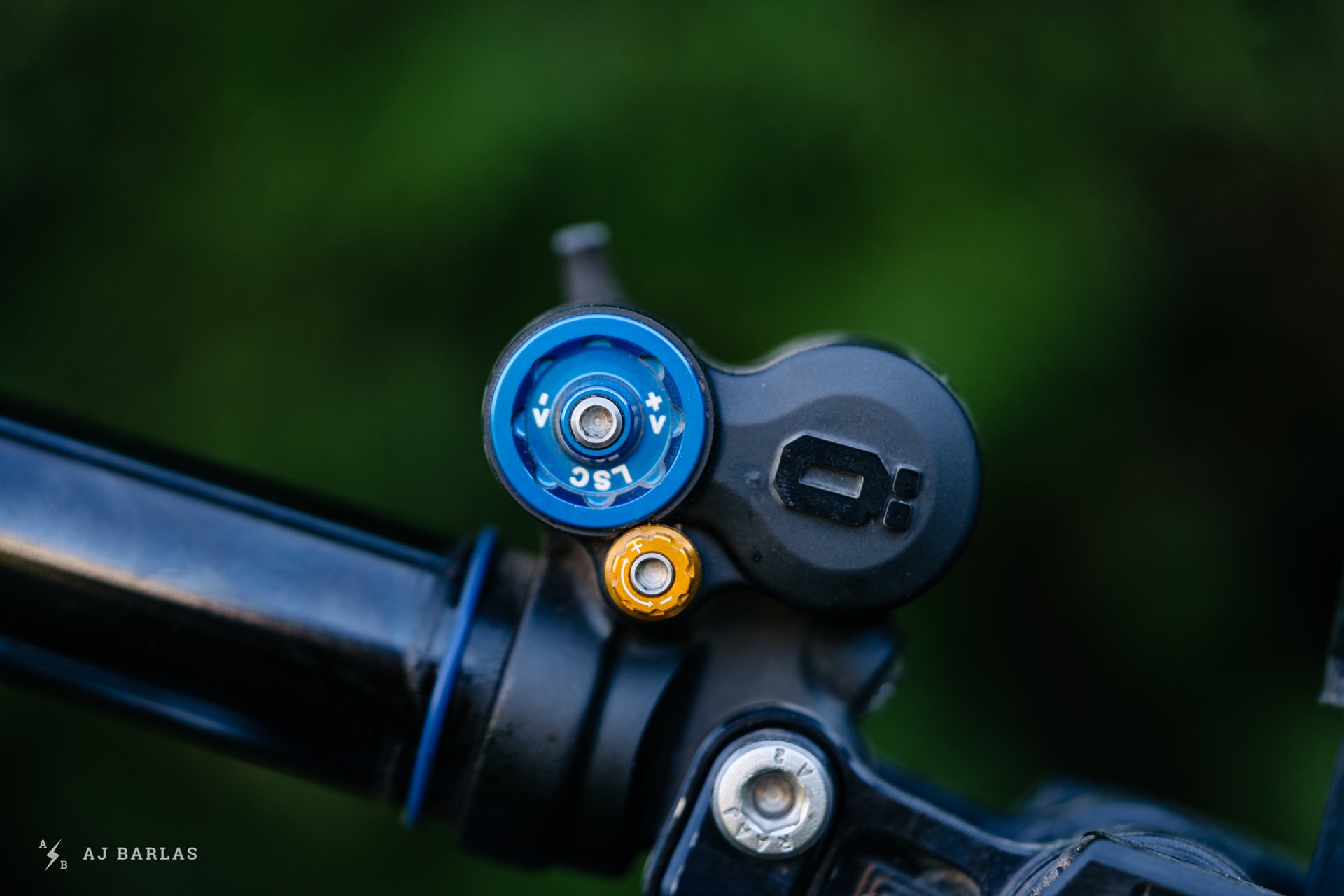
Adjusting the damper's LSC and rebound requires a 3mm hex key. The detents are crisp and clean.
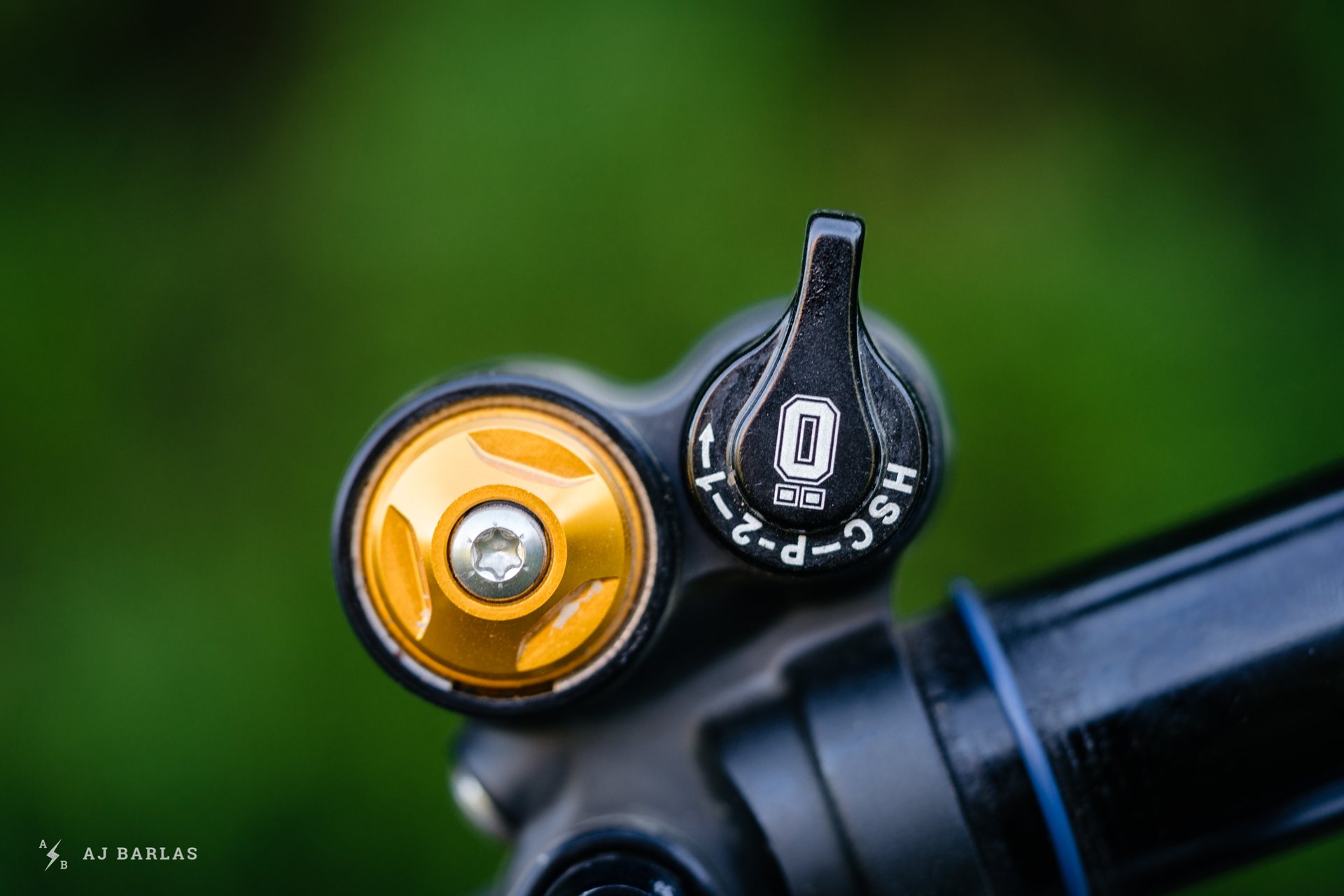
The HSC dial is adjusted by hand so that users requiring the pedal platform can access it on-the-fly.
The damper isn’t the only place hiding twin tubes when it comes to the TTX Air. There are two options of the shock available and the larger features a twin-tube air can, providing higher volume in both the positive and negative chambers. Öhlins feels that with multiple stroke lengths and a wide variety of kinematics one size doesn’t fit all and they developed the two variations to better serve customers. With the single chamber air can, only the large puck style volume spacers work but for the larger double air can, smaller clip spacers are provided to offer greater fine-tuning. Max pressure on the small can TTX Air is 300psi while the double is 325psi
Öhlins developed the TTX Air taking full advantage of the metric design. They claim more support and bushing overlap make this a more robust air spring and from my experience, this is accurate. It’s a good thing too after the issues that surfaced with their earlier STX22. With the shock mounted to my GeoMetron G1 (a bike that puts considerable side load into the shock and part of the reason for the spherical eyelet bearings in the bespoke EXT Storia) side load on the shock was bound to be tested.
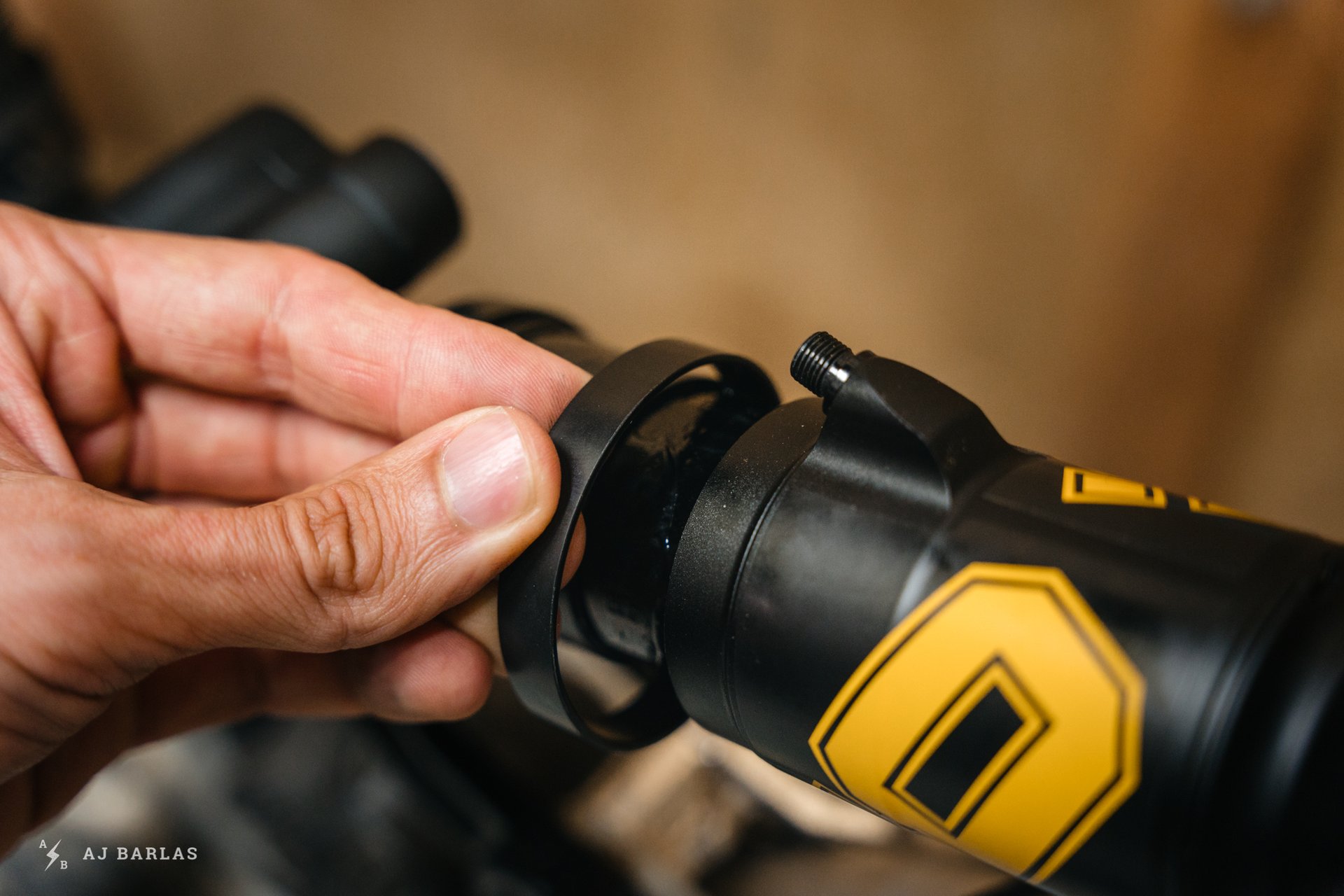
The outer air sleeve provides fine tuning of the air spring using these 2,000mm³ reducers.
Setup + Squish Time
When first bolting the TTX Air to my G1, the air can was left as it arrived; with an 8,000mm³ reducer clipped into the main can and two 2,000mm³ reducers in the outer air sleeve. Once happy with ride height I adjusted the dampers to suit, achieving an initial setting to work from. That left me with ~22mm sag (~33%) with the HSC open (Pos 1 on the dial), LSC was initially left open (12 out) and the rebound was 7 out. The first ride was in the Whistler Bike Park and I quickly found I needed more support. The LSC compression was wound in, eventually settling on 4 clicks out and the HSC was moved to position two. Position 2 on the HSC had a notable effect on the shock and I found the rebound needed to be opened, allowing the oil to flow more freely as the heavier HSC setting slowed things down.
Eventually, I settled on 138psi to achieve 20mm sag (30%) and with the largest reducer (12,000mm³) in the main air chamber, the bike held its shape well. I switched between positions one and two on the HSC lever, testing which I preferred more. In the bike park, with the air spring set to a combined 16,000m³ of reducers, I enjoyed more HSC. The bike held a better shape when loading up like a goon in high-speed berms and was composed off lips. On steep, rough trails like Misfire and Delayed Fuse, the extra compression held the bike up during the sharp, repeated hits. Low-speed compression was left at 4 out and rebound settled at 8 out.
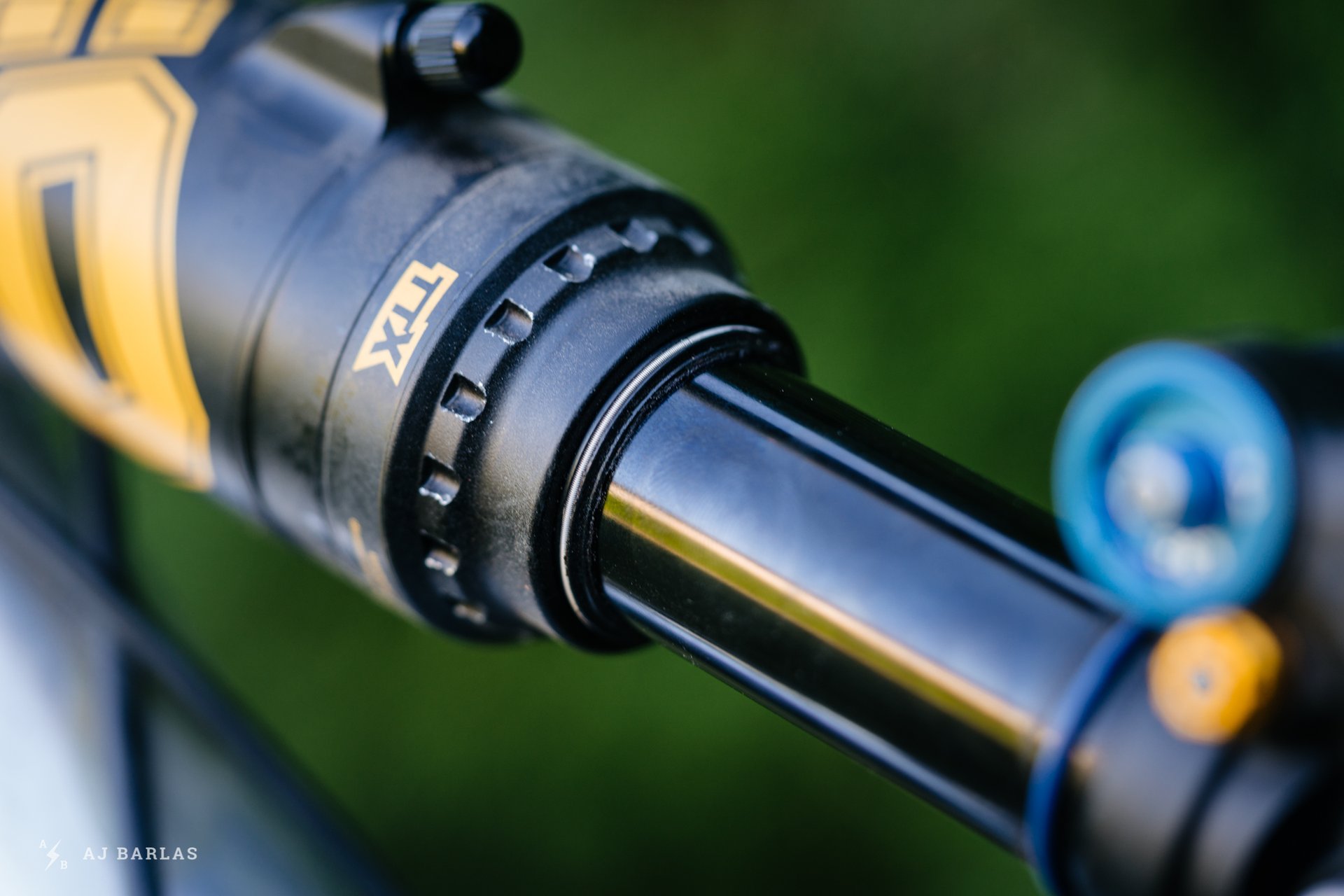
Öhlins has been vocal about the glide of the TTX Air, so much that I refused to accept it as truth. But on the trail it's very smooth thanks to their efforts.
Öhlins was vocal about the effort taken to reduce friction and sideload in the system and it's clear on the trail. The TTX Air shock is remarkably smooth, gliding through its travel with ease, while the spring and damper combined offer excellent control and stability. There’s a clear lack of friction from the spring and its initial touch is smooth and easy to initiate. Control of the stroke is great and the shock never feels sudden or stuck. Transitions between compression and rebound felt seamless and the port between the positive and negative springs is indistinguishable leaving no dead spots.
I sometimes feel the pop attributed to air springs is at times stiction in the system. The way air pressure builds when compressed causes it to return quickly but after riding the TTX Air, I’ve found it to be more controlled in this regard. The lack of friction in the shock results in it being very predictable off lips and in rough terrain the rear wheel tracks the ground sensationally. The feel of the TTX Air is similar to a coil in this regard with the smooth, unrestricted movement allowing it to move consistently.
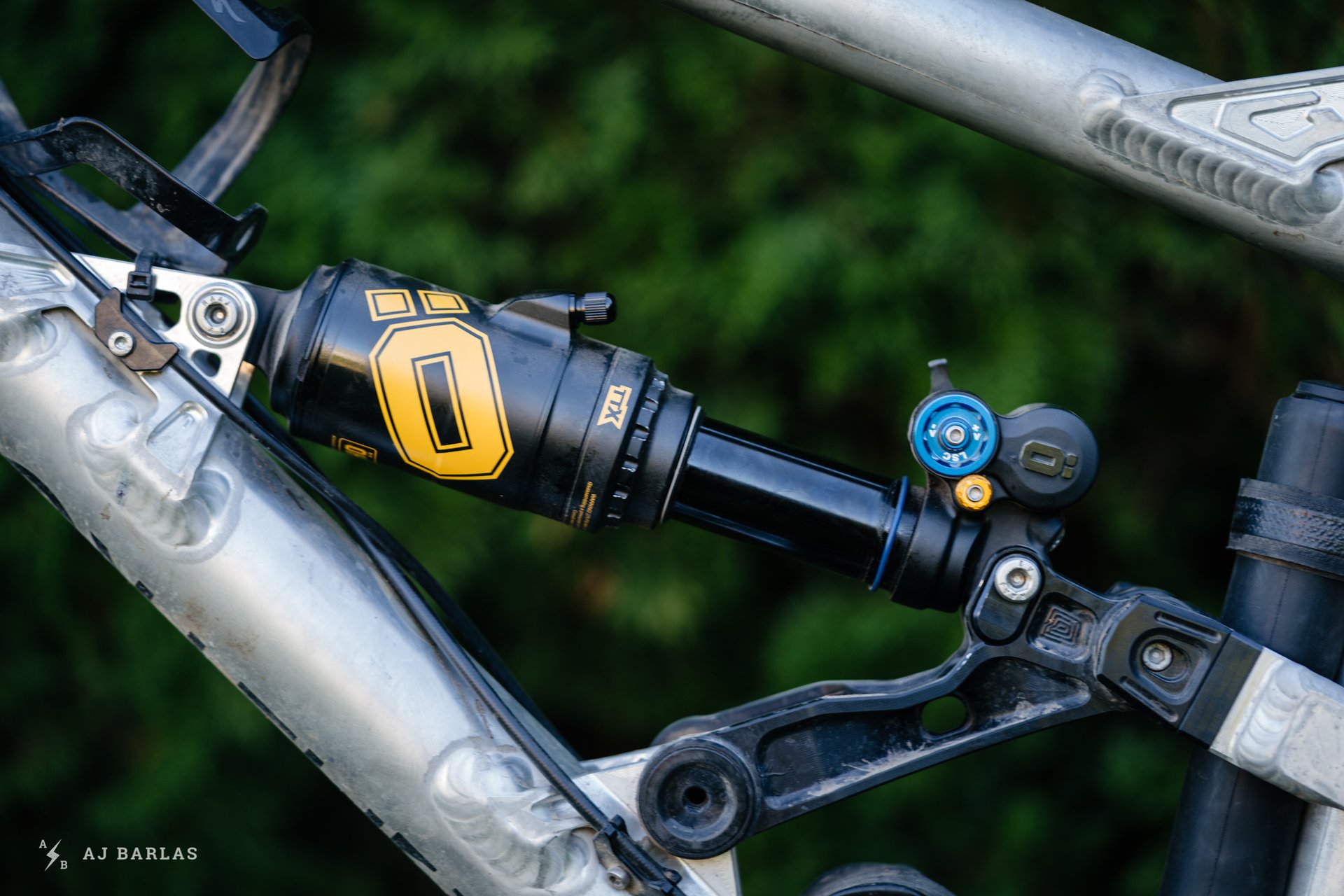
The Nicolai/GeoMetron G1 design introduces some sideload to the shock and I was able to test the TTX Air's ability to handle it. Under extreme situations I was able to cause it to bind but any shock not on spherical eyelet bearings would have done the same, and potentially under less stress.
The only way I achieved any unusual or unpredictable traits from the TTX Air was when loading the bike aggressively into a choppy corner or occasionally when tossing the back wheel around like a goon – as you do in the bike park. Each situation produced high shaft speeds and sent the shock deep into its stroke rapidly. With the bike aggressively side loaded, I could feel the shock resisting. Because of the aforementioned side load of the G1, I found the TTX Air to catch in these situations rather than continue to absorb the impact like the stock EXT with spherical eyelet bearings. Hardly the fault of the Öhlins shock but quite noticeable coming from the bespoke EXT Storia built to remedy this situation on the G1.
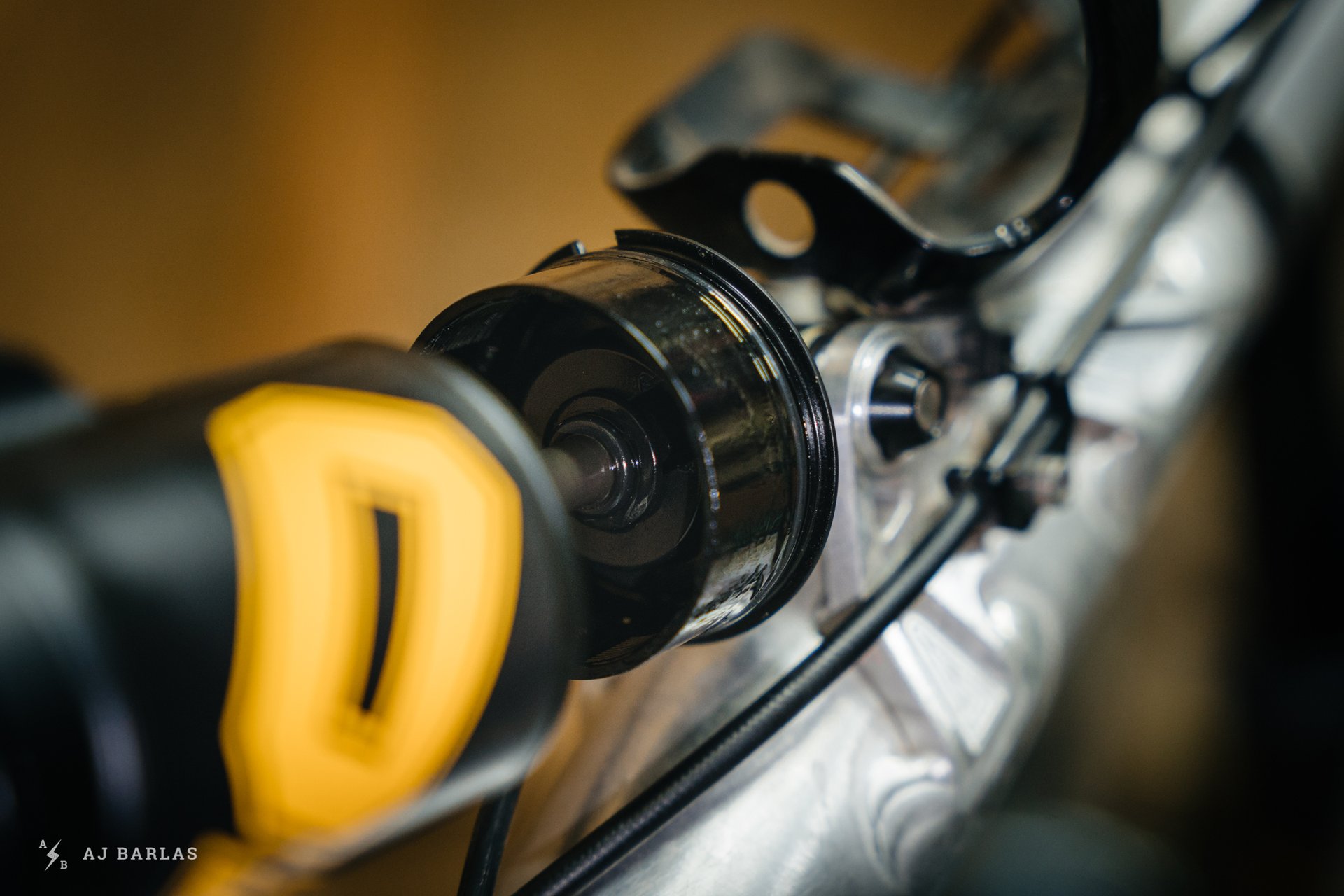
The largest puck clipped into the bottom of the main air chamber. This wasn't as easy to service or install as the smaller clips in the outer sleeve.
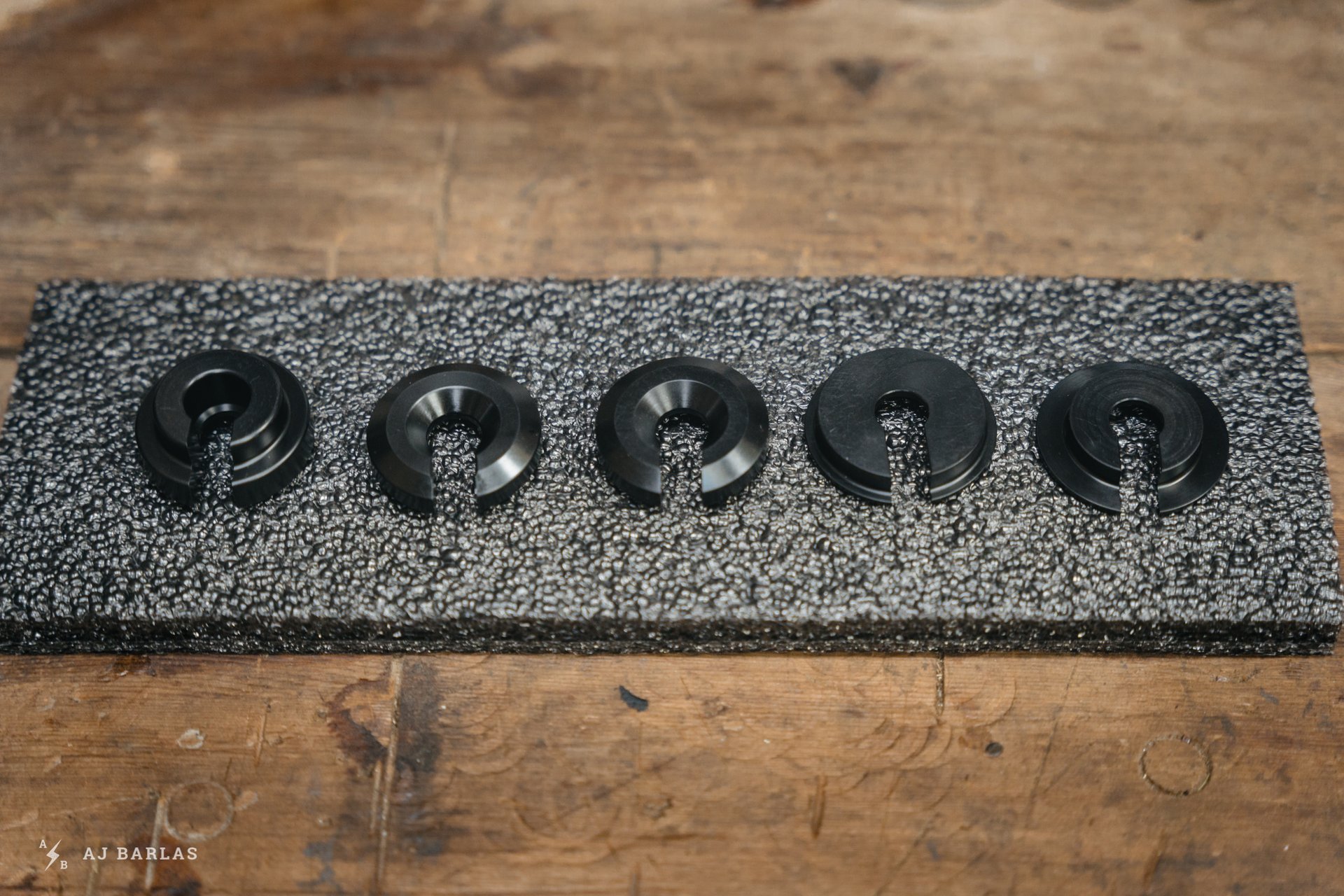
The range of reducers available for the main chamber of the larger volume shock (left three). All of these, plus an even smaller one are used in the smaller volume, single chamber shock.
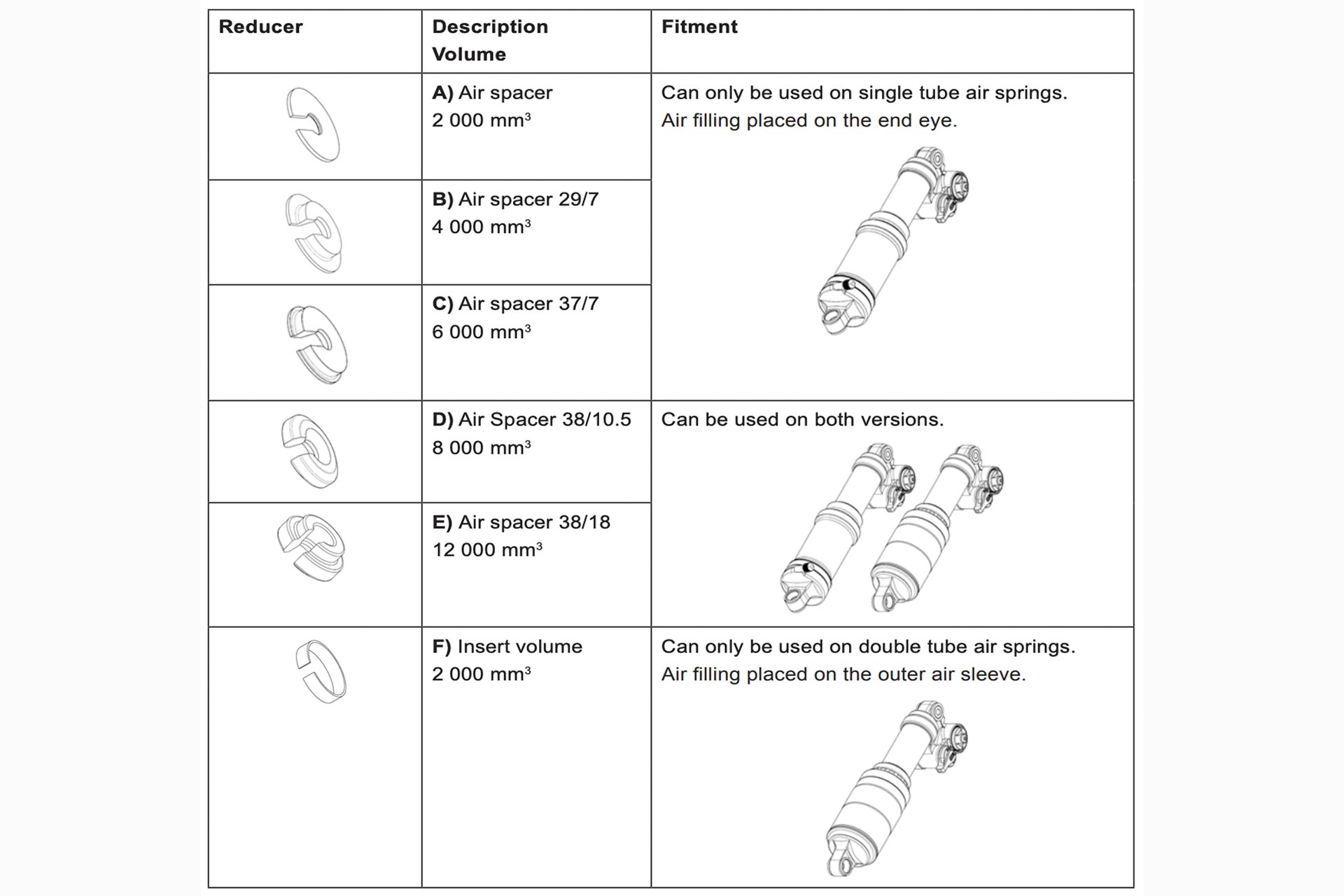
The TTX Air volume reducer recommendations based on shock models.
After a few more rides I wanted more end stroke protection. Adding more pressure took away the soft initial touch and stood the bike too tall for my taste. The remaining two 2,000mm³ spacers were added to the outer sleeve of the air can, bringing the reducers to their max for this shock at 20,000m³. Going whole hog, I anticipated needing to remove one to settle in the middle but found it to work well. The air spring was set to 138psi for 20mm sag (30%) and the LSC was opened to 7 out. With this setup in Squamish, I found myself switching the HSC dial back to position one; the lightest setting.
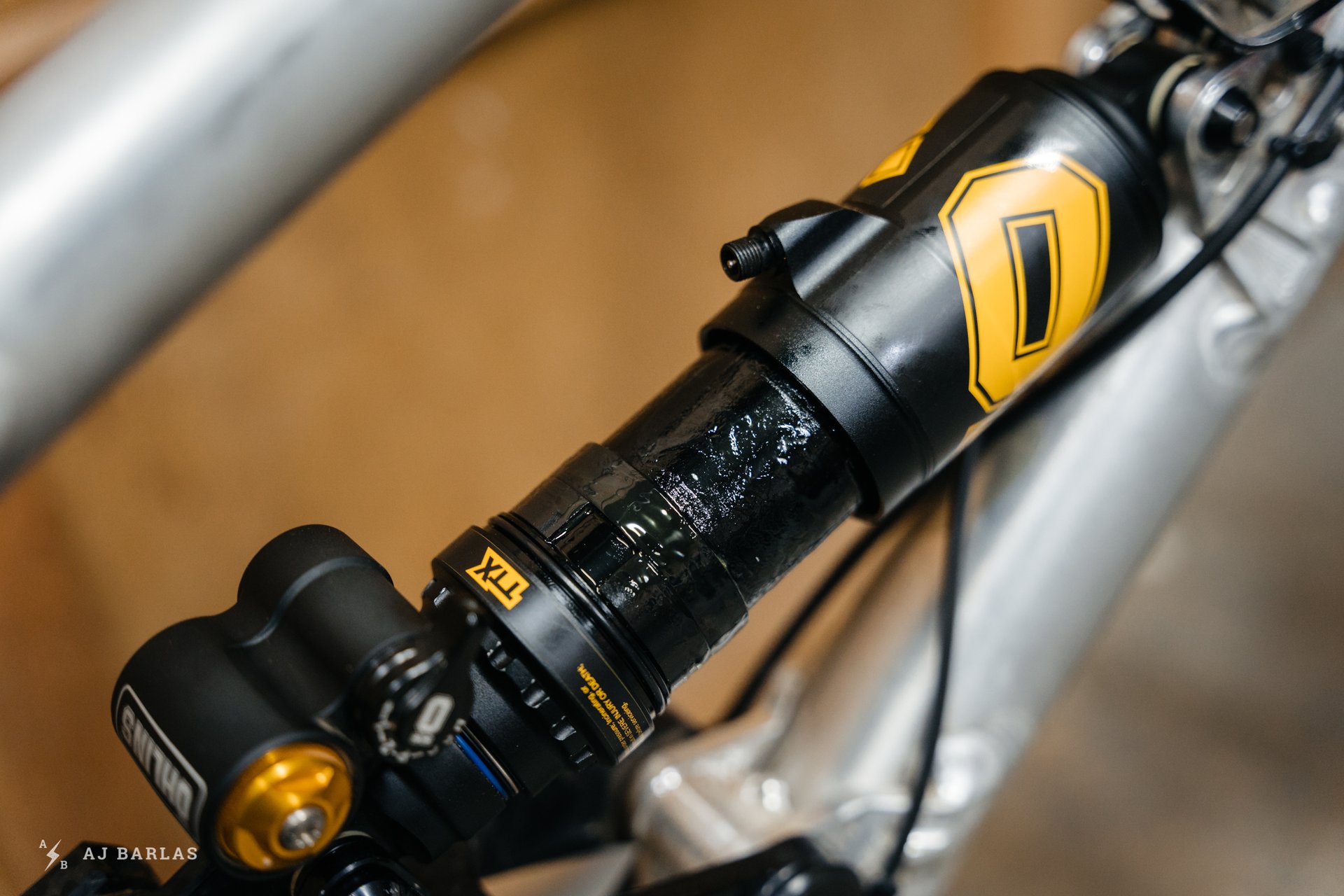
The outer sleeve is easy to add and remove the 2,000mm³ reducers to. Two were in the shock but I ended up using the full four.
The amount of progression provided through the stroke felt great and despite the shock being full of reducers, there was no harsh wall or unpredictability at the rear wheel. The build of progression was gradual and controlled, while the damper and effortless glide of the shock continued to provide great grip. Less feedback was felt through my feet when sitting in the mid-stroke, providing a smooth ride and allowing me to focus on the trail when encountering rough, or new terrain. As a flat pedal rider (these days) this was a welcome characteristic to the smooth action of the TTX Air.
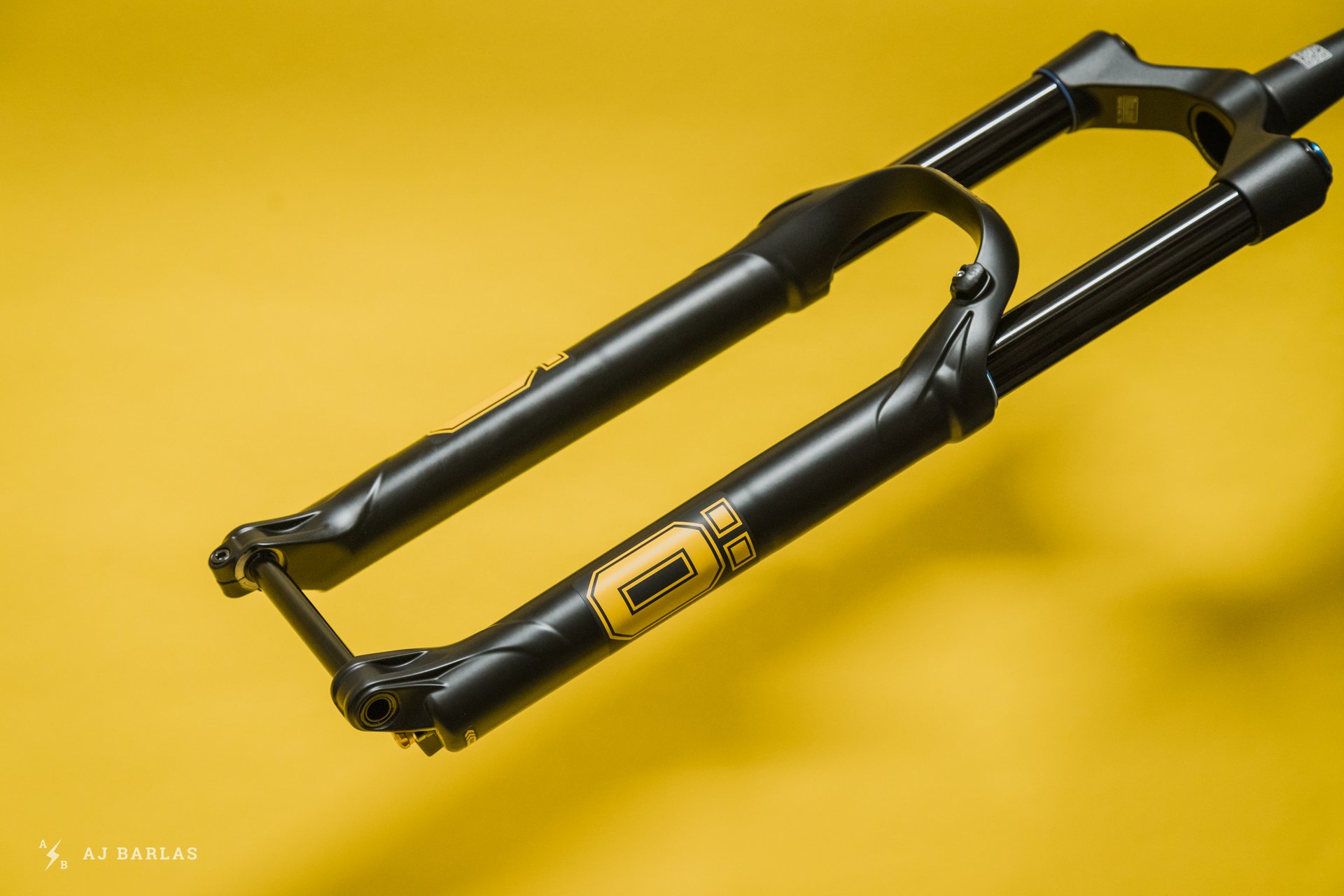
After a full year riding the RXF6 m.2 I've settled on the coil but the air spring fought admirably for my approval.
RXF36 m.2 Air
A year after mounting the RXF36 m.2 to my G1, the fork remains creak free. Following the m.2 coil review, the spring was switched to the self-contained air spring. The switch is easy to perform at home but the air-sprung fork is sold with a lighter damper tune, so I visited Vorsprung to have the new shim-stack configuration installed. Since then I’ve happily continued to ride the fork through the challenging dry, rough and abrasive conditions I look forward to each summer in Squamish.
Highlights:
- Air and Coil sprung options.
- Coil provides 130–170mm travel. Air is 150–180mm
- 160mm air and coil spring options tested
- Different offset options available:
- 27.5: 46 or 38mm | 29: 51 or 44mm
- 29er 44mm offset option tested
- New TTX18 damper cartridge
- Retrofittable internals
- SKF seals
- Weight: 2,393g (Coil w/ hardware/axle and an uncut steerer)
- 2,149g (Air spring w/ cut steerer and star nut)
- MSRP: 1,250 USD/1,190 Euro
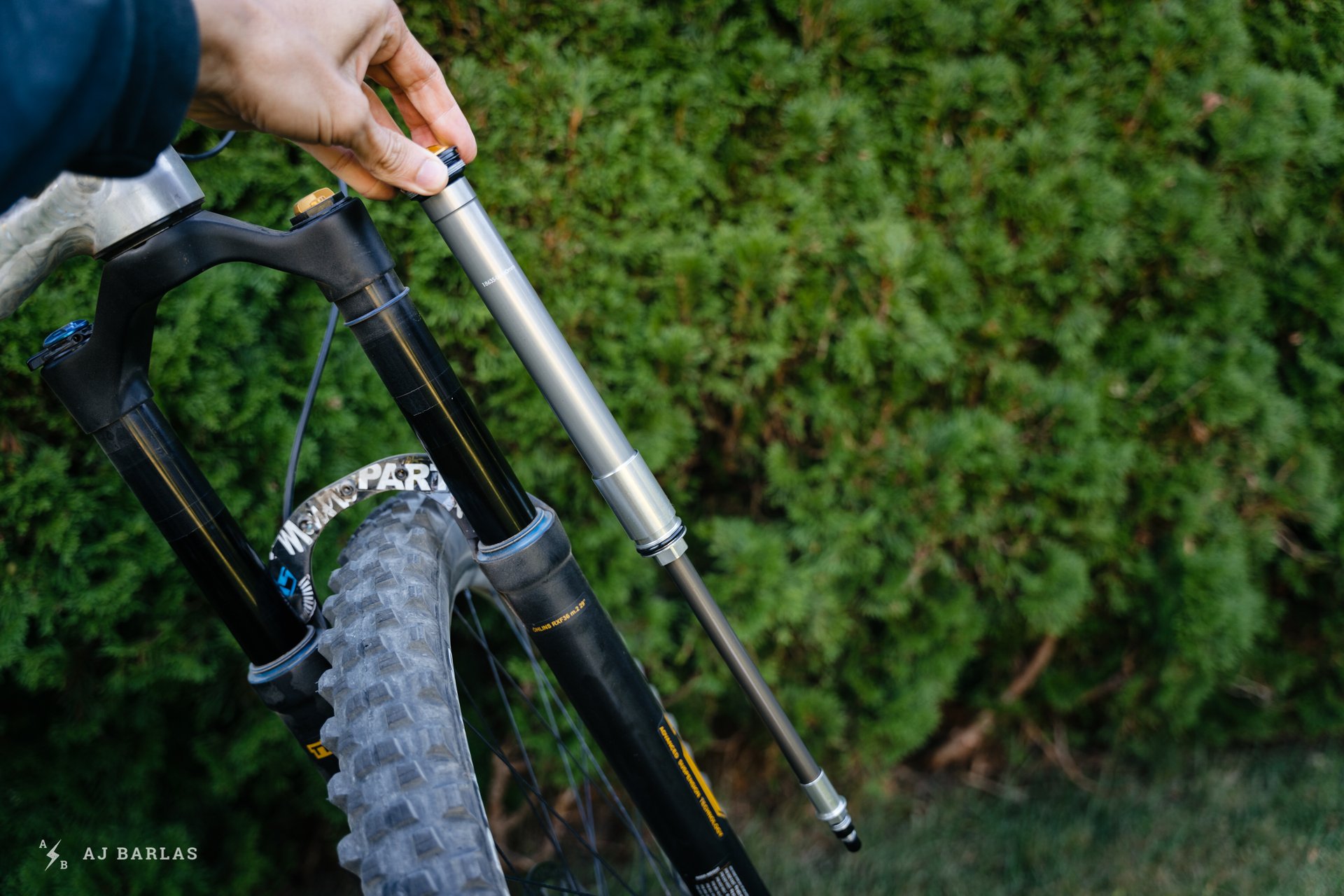
I forgot to get photos of the fork with the air spring in. Minus the foot stud and top cap differing, it didn't look any different externally.
The Tech
In the coil m.2 review I noted how impressed I’ve been by the structural stability of the RXF36 m.2 chassis and those feelings remain. The front wheel tucks under less during heavy braking, especially in steep, choppy sections and steering accuracy is great. Less flex also allows the fork to activate more immediately and with less chance of friction caused by flex on the system. Öhlins also allows up to a 223mm rotor on this fork and I’ve been testing a brake set with a fruit platter sized front rotor for more than a month with no issue.
The ability to switch between air and coil is unique in the day of primarily air-sprung forks. There are ways to make a coil work in competitors forks – like the aftermarket options from Push or Vorsprung – but much of the time switching back to air isn’t recommended. To do that a new CSU is required, making it a costly transition. While the RXF36 m.2 makes switching back and forth possible, would anyone want to? I struggle to see why but that doesn’t mean it’s not appealing for someone. A scenario that may come up is purchasing a coil option to try but perhaps not getting the ride characteristics hoped for. In this situation, rather than having to buy a new fork or CSU, an air spring cartridge can be purchased for 117.50 USD/103.40 EUR and slid into place.
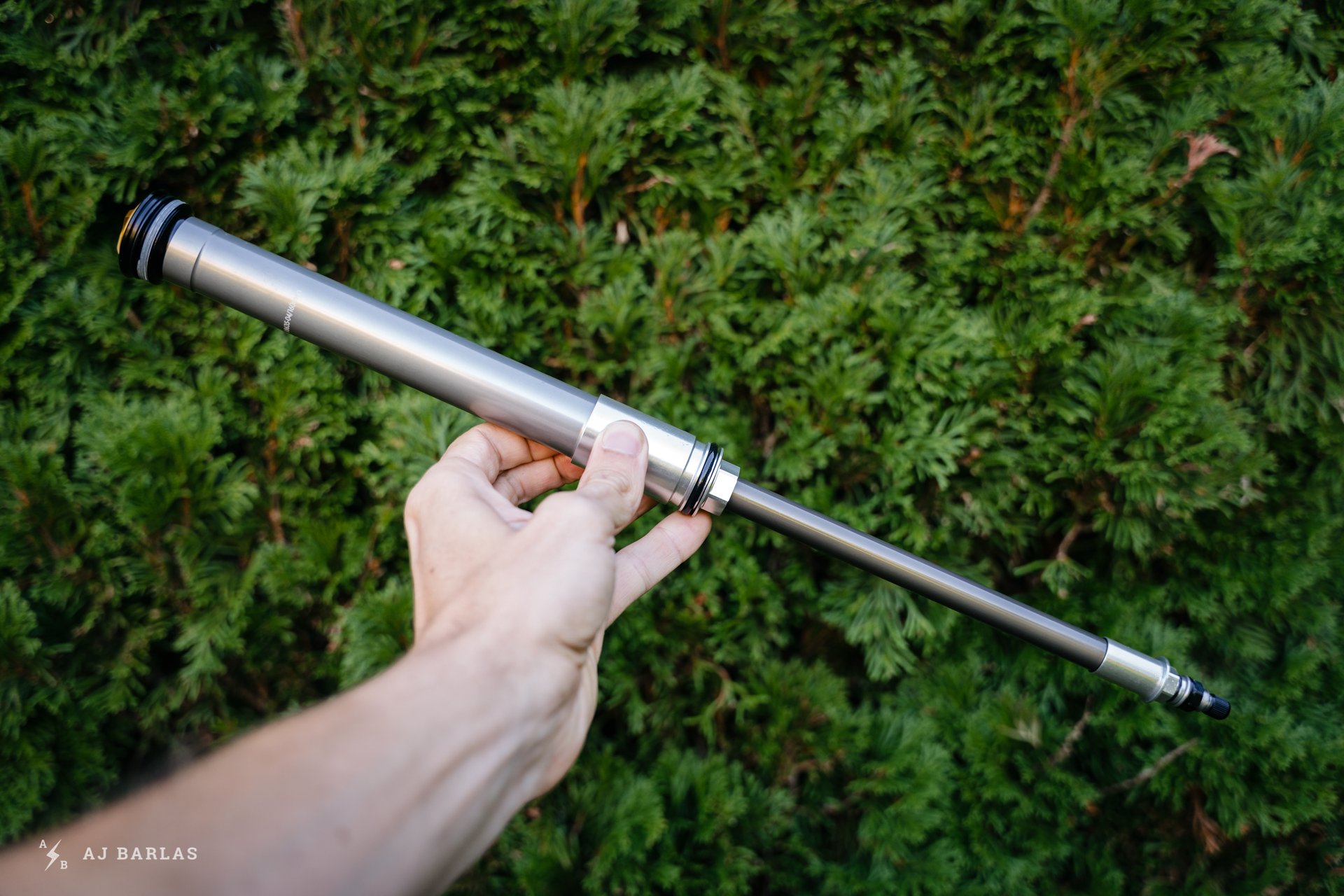
The air spring can be installed relatively quickly if you have the coil kit tool. I tested the fork at 160mm.
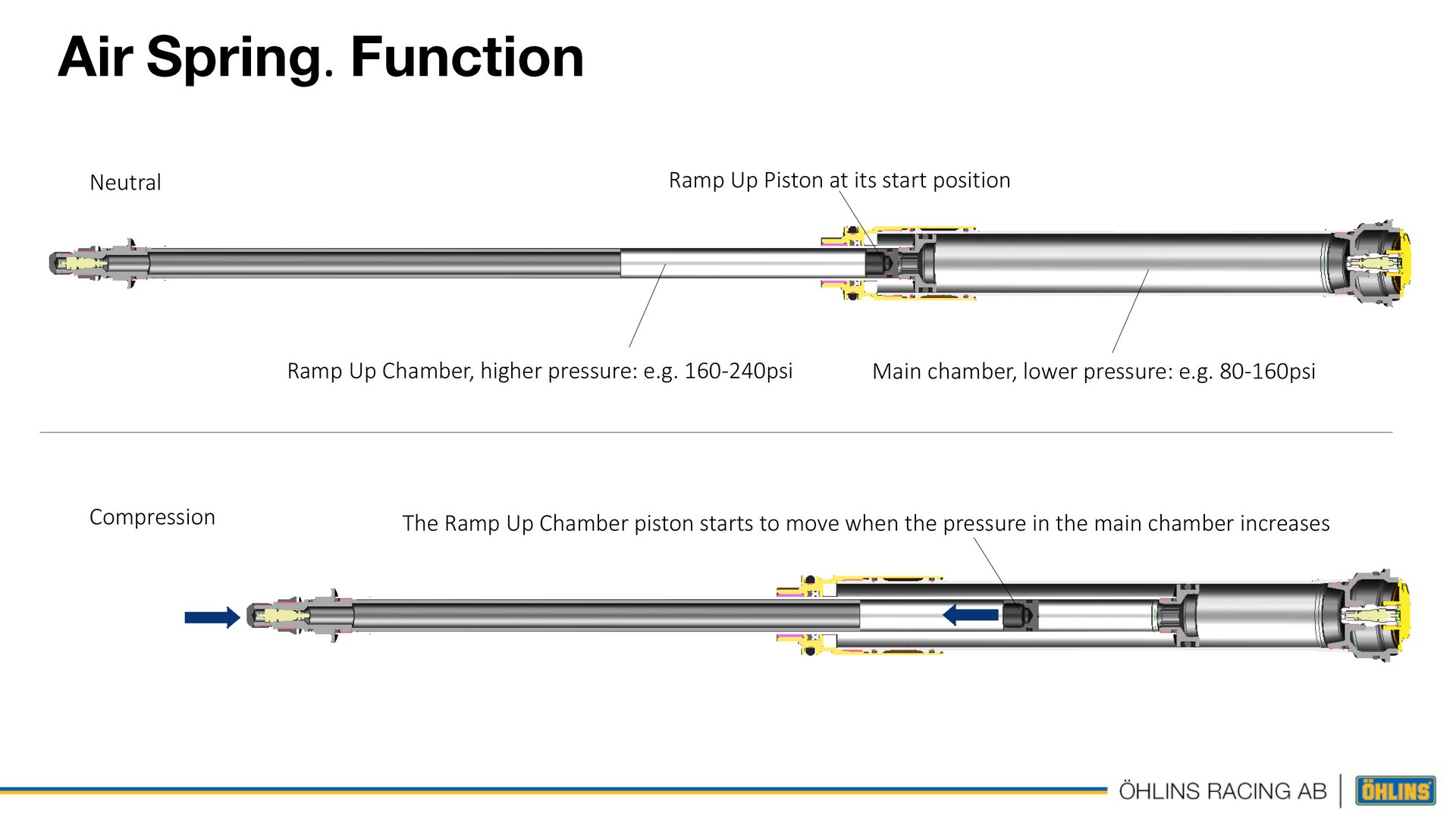
A brief look at how the internals of the air spring work.
Öhlins’ air spring is a twin-piston, three-chamber system featuring the main chamber, accessible from the top of the fork, and a ramp chamber accessible from the bottom. Adding air to the main chamber sets the ride height of the fork as it fills the positive and negative air springs. A transfer port handles airflow between the two, as with many other forks, but it’s worth noting that the Öhlins is silent and even focusing on it during setup I’ve failed to notice anything. Heaps of forks are getting better in this regard too but two years ago when I first got a taste of the RXF36 m.2, the clean transfer between positive and negative was a first for me. Where things differ with the m.2 is how riders tune the end stroke. Rather than the puck system we’re more accustomed to seeing, Öhlins use another air spring to tune progression. This presents heaps of tune-ability but can be daunting for riders who don't like to tinker.
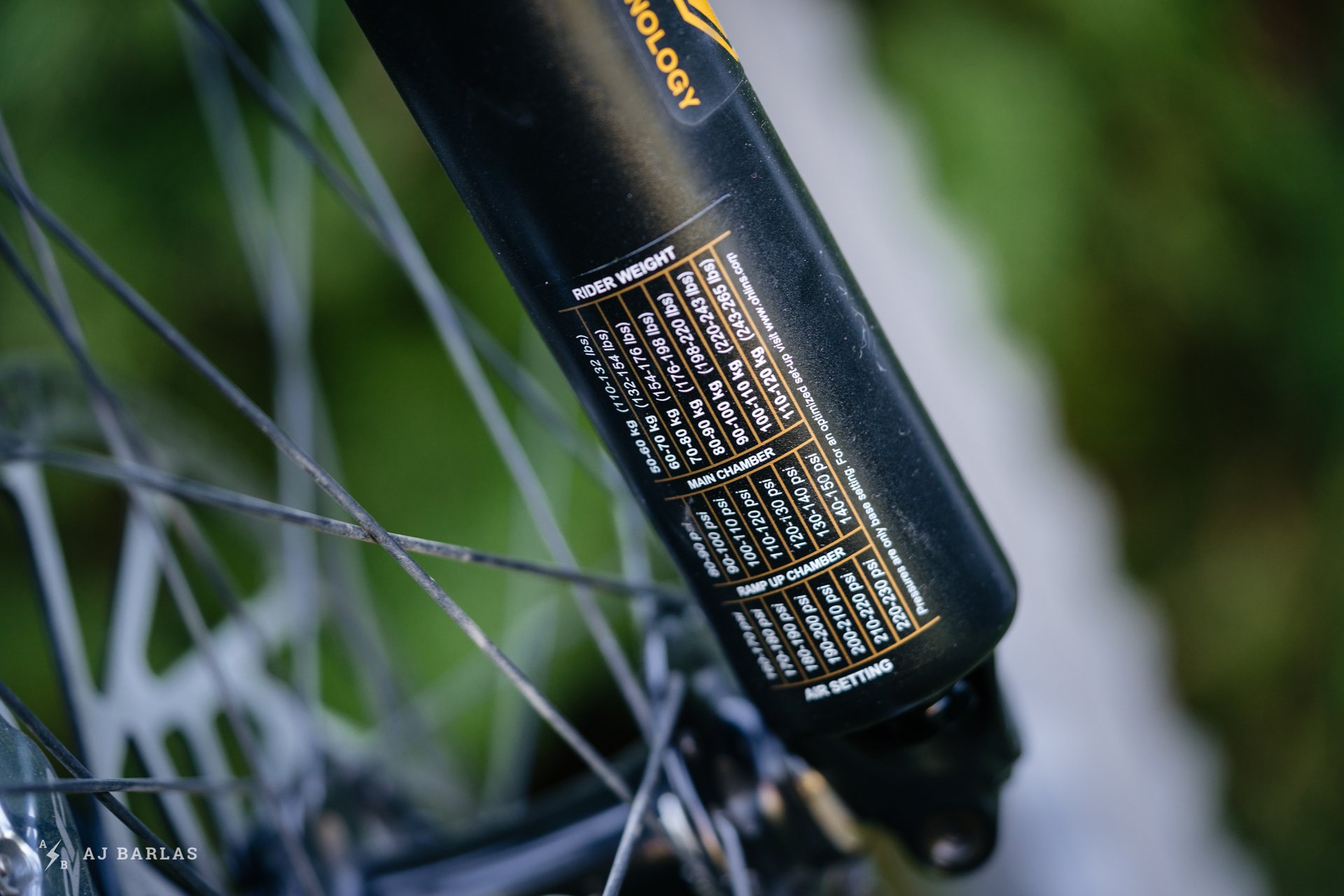
The air spring recommendations on the fork help give a starting point that can quickly be altered in the direction needed. I found I ran the main chamber lower than the starting suggestions and the ramp chamber was within the range recommended.
As the main chamber builds pressure under compression, the piston of the ramp chamber starts to move, building resistance as it does. It provides a different feel on the trail to the typical puck systems thanks to dynamic changes. A puck system simply increases pressure within the main chamber as the fork is compressed. Because of this, I didn’t notice any “wall” to the ramp, even when experimenting with high ramp and lower main chamber pressures. It’s still possible to achieve an overly progressive bottom end to the stroke but the harshness typically experienced by running heaps of tokens and low pressure isn’t an issue.
Something we’ve heard much of with new suspension releases is ‘increased negative air spring volume’ and that was the same for the new RXF36 air spring. The increase provides improved small bump and the ability to achieve greater mid-stroke support when compared to Öhlins’ previous air spring. These updates were brought across from the development of the World Championship-winning DH38 and combined with minimizing friction in the system, make for a very nice feeling air spring.
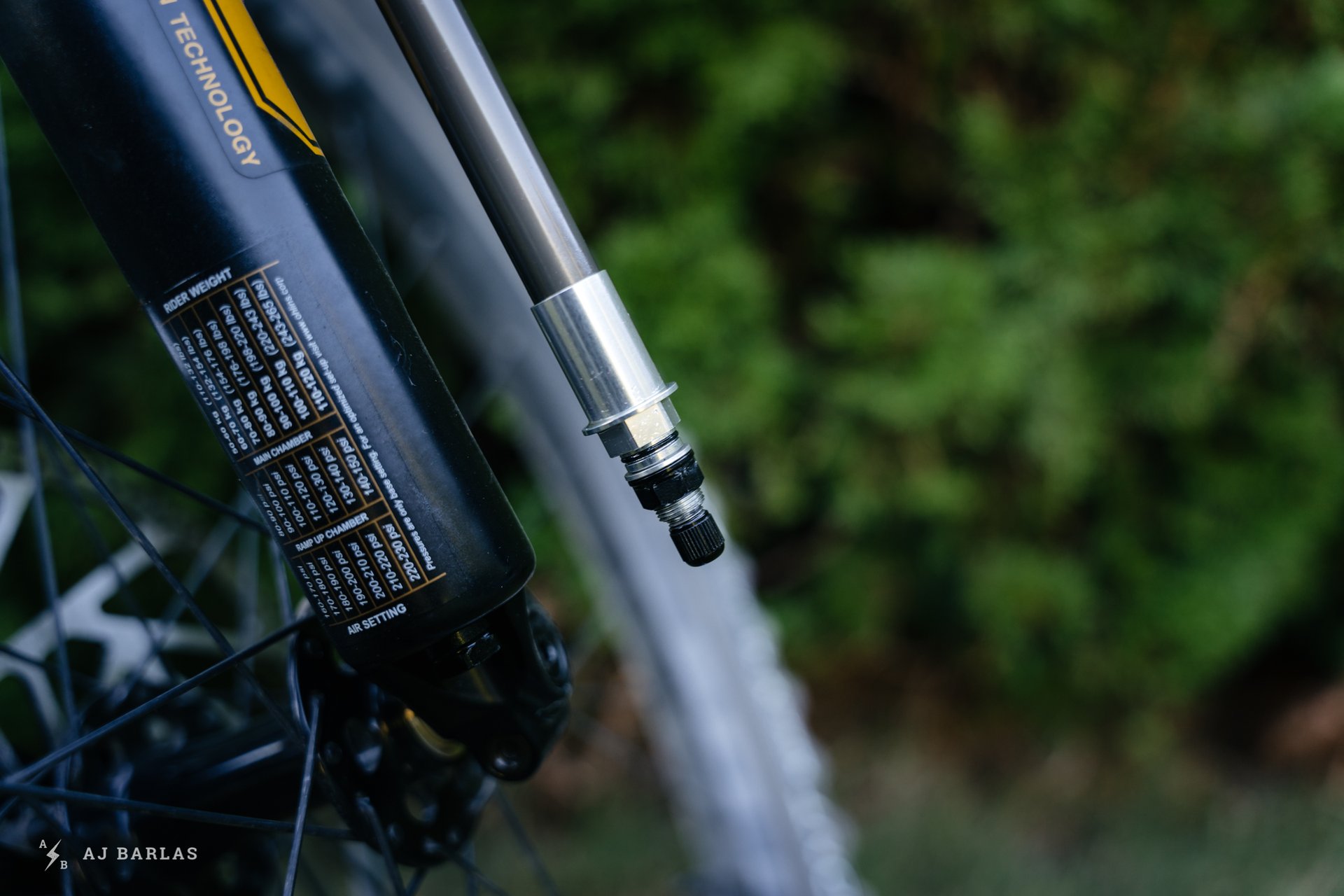
Airing up the fork is a bit different. The ramp chamber is filled first…
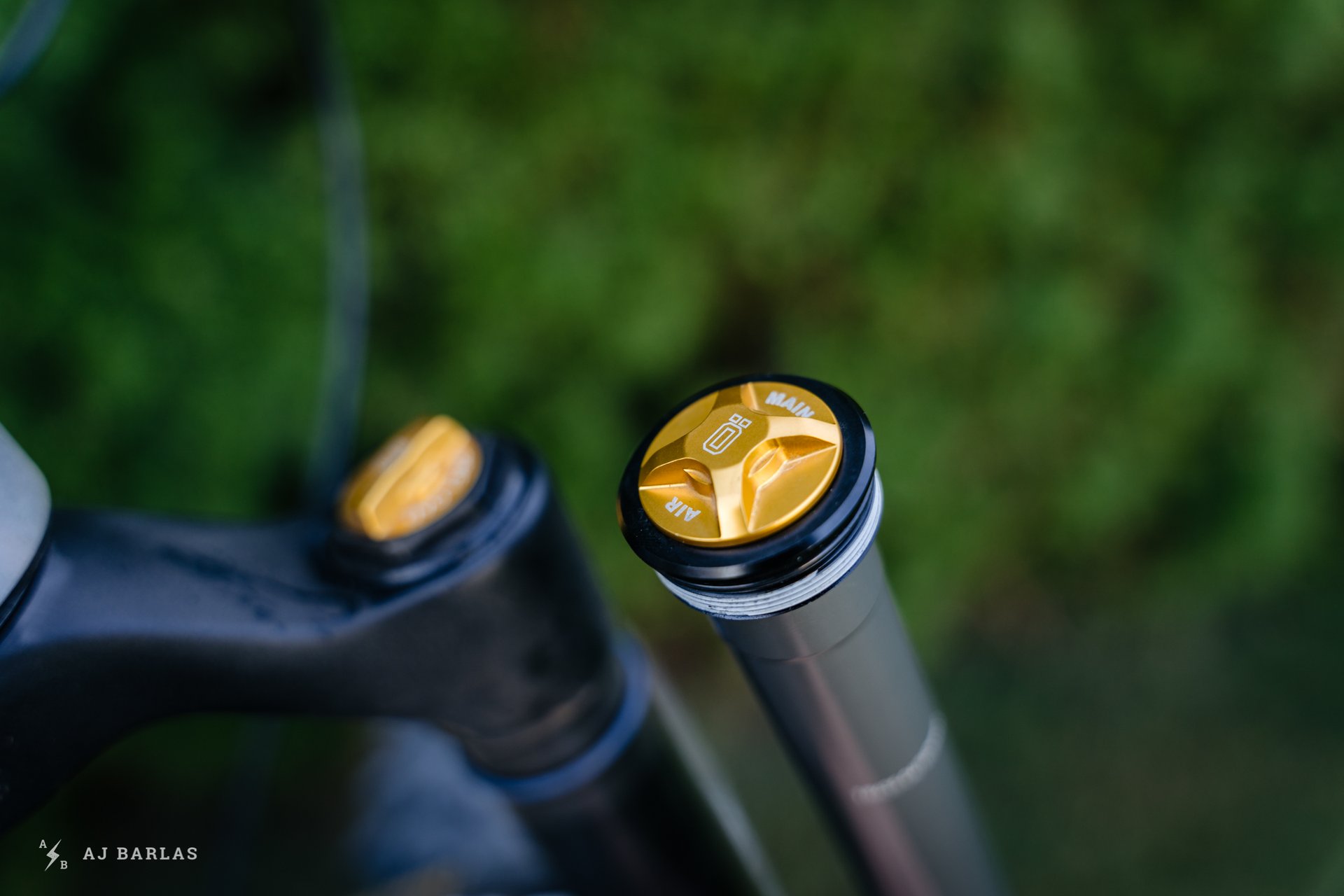
Then air is added to the main chamber, accessible at the top of the fork.
Setup + Comparison Time
Setting up the m.2 air differs slightly thanks to its ramp chamber. First, air is pumped into the valve at the bottom of the right fork leg. The initial setup is best done following Öhlins’ recommend start point of double what’s planned for the main chamber. Once at the desired pressure, things move to the top of the fork where air is added to the main chamber. Initially setting the pressure to the amounts recommended on the back of the fork leg is a good starting point but as I’ve found on my G1, I required a lighter spring than the recommendations.
Adjusting the air to suit can take a bit more time but it offers heaps of flexibility, even compared with other air-sprung fork options. Eventually I achieved the static shape I was used to with the coil – which was my benchmark thanks to how good the bike felt overall. That put me at 96psi in the main chamber 184psi in the ramp. Over time I tested offsetting the two, pushing the ramp chamber closer to double the pressure in the main. After a while, I settled on 94psi and 181psi to achieve the ride I wanted but I did drop the ramp down as far as 180psi. This resulted in a very linear feeling fork but I was able to achieve full travel too easily and had nothing in reserve for those ‘oh shit’ moments. With the pressure set back to 181psi, I was able to save the last 10–15mm for extra protection.
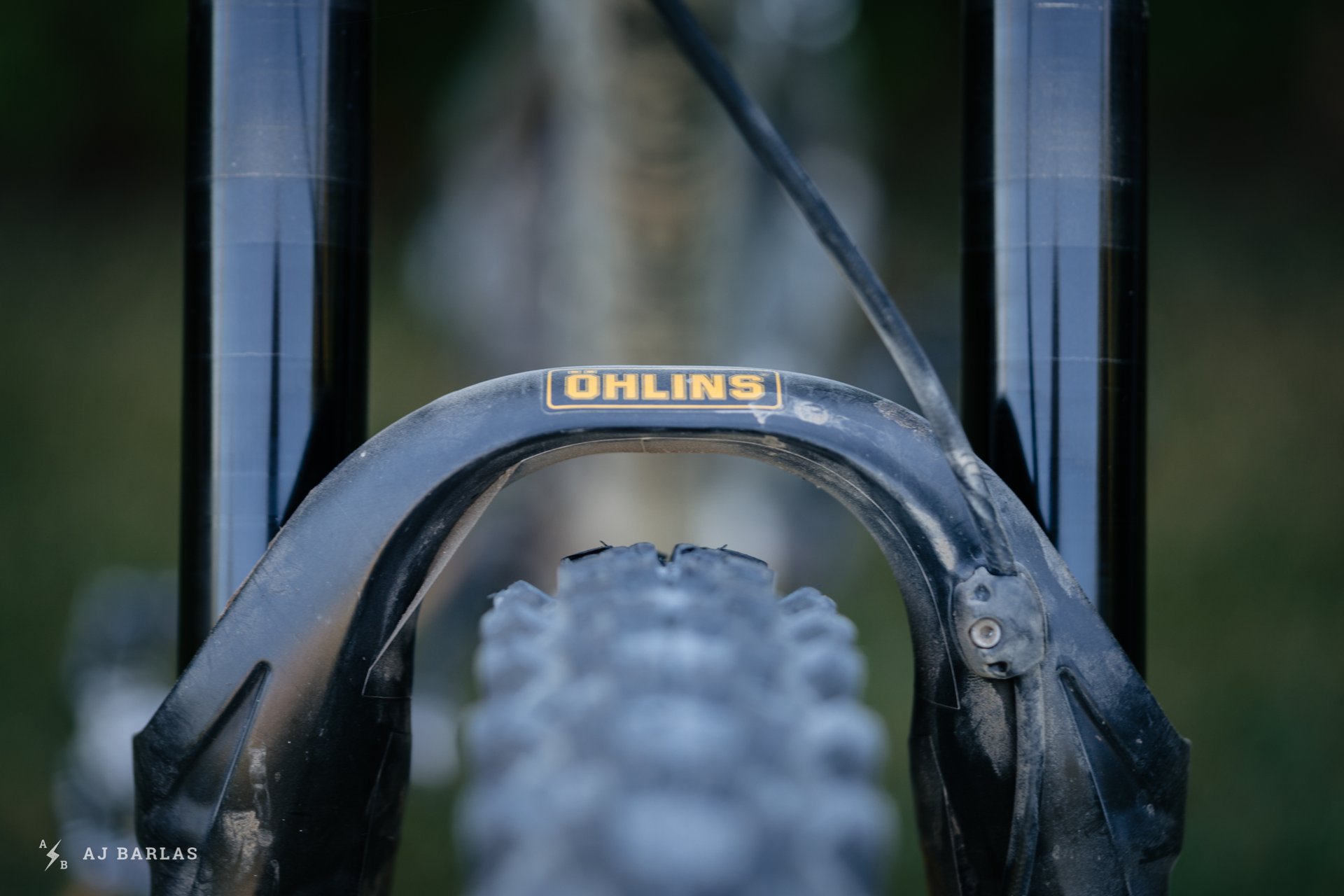
The RXF36 m.2 has heaps of tire clearance.
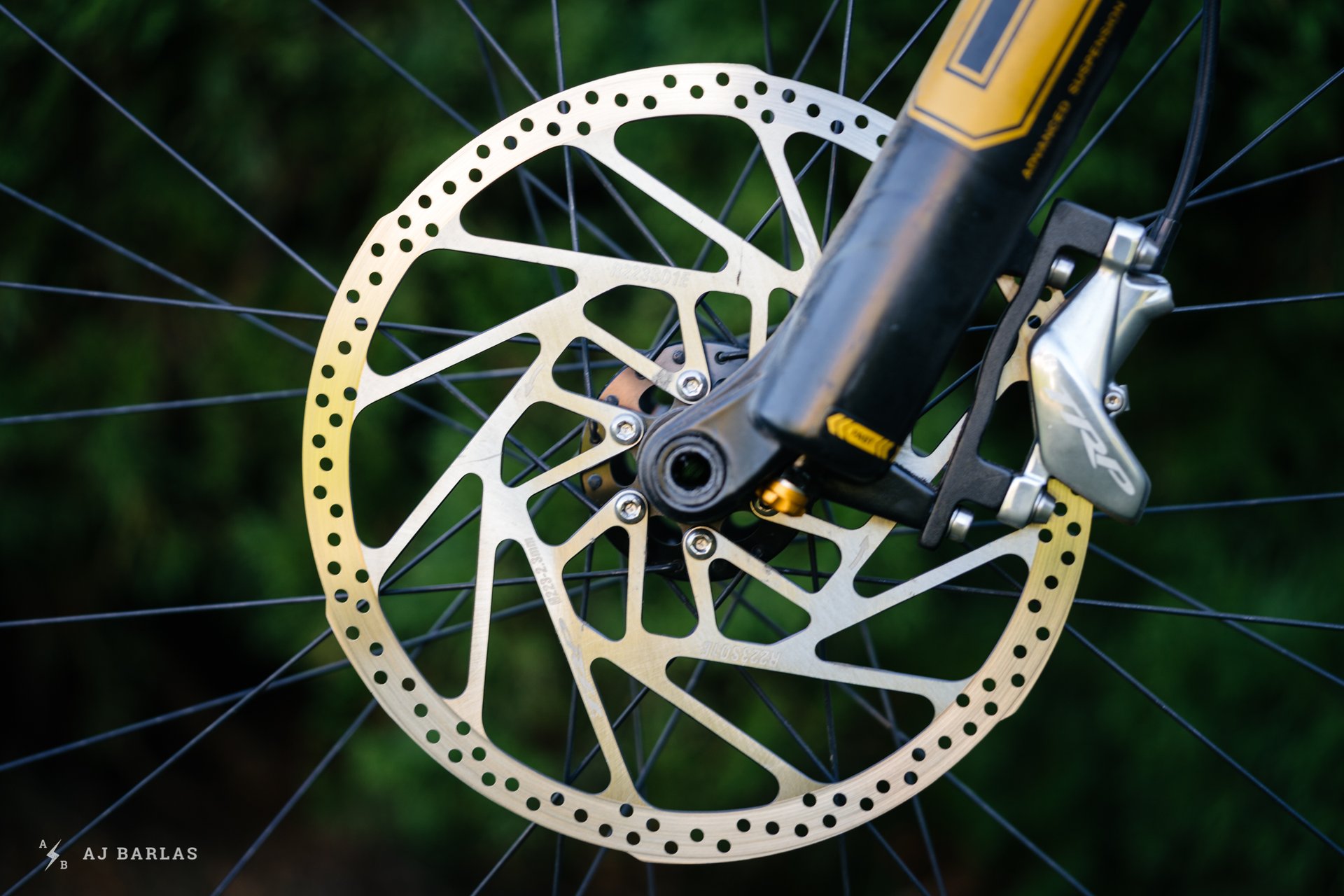
It's also approved to run the new, big sized 220/223mm rotors.
Dropping pressure while increasing the ramp chamber salvaged a surprising amount of support in the latter portion of travel while sitting quite deep into the stroke. The mid-stroke support in these situations suffered but it was interesting how rideable it was. I didn’t experience any of the sharpness typically encountered when doing similar using the puck system of other forks. The settings will differ from bike to bike, rider to rider but the point is the air-sprung Öhlins RXF36 m.2 offers incredible tuning flexibility. The air spring provides an excellent ride, moving in and out of the stroke smoothly and taking everything that can be thrown at it. Front wheel grip was excellent and the fork's ability to recover from big hits is commendable. Composure through a series of medium to large hits at speed was also great. The m.2 with the air spring, carried over much of the ride characteristics I enjoyed so much with the coil. I did find that while very tunable, I wasn’t quite able to achieve the mid-stroke support of the 2021 Fox 36 – which can be found quickly too – but compared to the 2020 model they’re equal.
When switching to the air spring, the damper was re-shimmed to a lighter C50 tune from the then stock C60 of the coil-sprung fork. This provided me with an almost identical setup in terms of compression but I did have to open the rebound between one and two clicks with the air spring. I continued to flip between positions one and two out on the HSC dial (pedal platform being 0). The LSC was set to the same position as with the heavier tune in the coil fork. The TTX18 damper found in the RXF36 m.2 does an excellent job of supporting and controlling the bike, transitioning like butter between compression and rebound to provide loads of control and grip. I found it comfortable with both the air and coil springs and never had issues with hand fatigue as a result of the fork. It’s a refined feeling damper offering a usable range at each end of the dials, except for the rebound, which can be slowed to almost nothing for my weight. For heavier riders requiring firmer spring rates, that extra depth from the rebound adjuster will come in handy.
- Bike: GeoMetron G1, size “Extra-Longest"
- Fork: Öhlins RXF36 m.2 Air
- Travel: 160mm
- Sag: 31mm / ~19%
- HSC: 2 Out (pedal platform is 0) / LSC: 12 Out
- Rebound: 13 Out
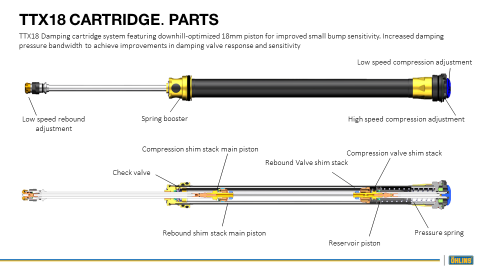
The spring booster, pictured on the upper diagram above, is found at the bottom of the damper. This clever device uses the air that builds in the lowers to provide progression at the end of the stroke. With this I've found the coil to have excellent support at the end of its travel, providing progression where a coil naturally doesn't have any.
Once air spring testing was complete, I swapped back to the coil. I prefer the lighter initial touch, which is great with the air spring but not quite as sensitive as the coil. I also find the fork's ability to effortlessly move in the mid-stroke while providing great support, benefits my riding more than the adjustability of the air spring. On top of that, I prefer the coil luxury of not having to check air pressure. Regardless of temperature or elevation, the coil requires essentially zero attention. When switching back to the coil with the lighter compression stack, I stopped into the damper more, settling at 11 out for LSC and adding 2 clicks of rebound, slowing it down from 13 out to 11 (I was twelve out with the stock C60 stack).
Öhlins has updated the stock damper tunes and now the coil fork comes with a C50 tune, the same as I'm currently using, and the air has gotten lighter again; now C40. This allows lighter riders to make use of the range available while heavier or more aggressive riders can still have the control needed. I didn’t have an issue with the C60 tune of the stock coil fork but was sitting toward the open end for several settings. There’s still heaps of room for the fork to be stiffened up so Öhlins going lighter again makes sense. And if the stock tunes aren’t working there’s a large bank of shim stack configurations available.
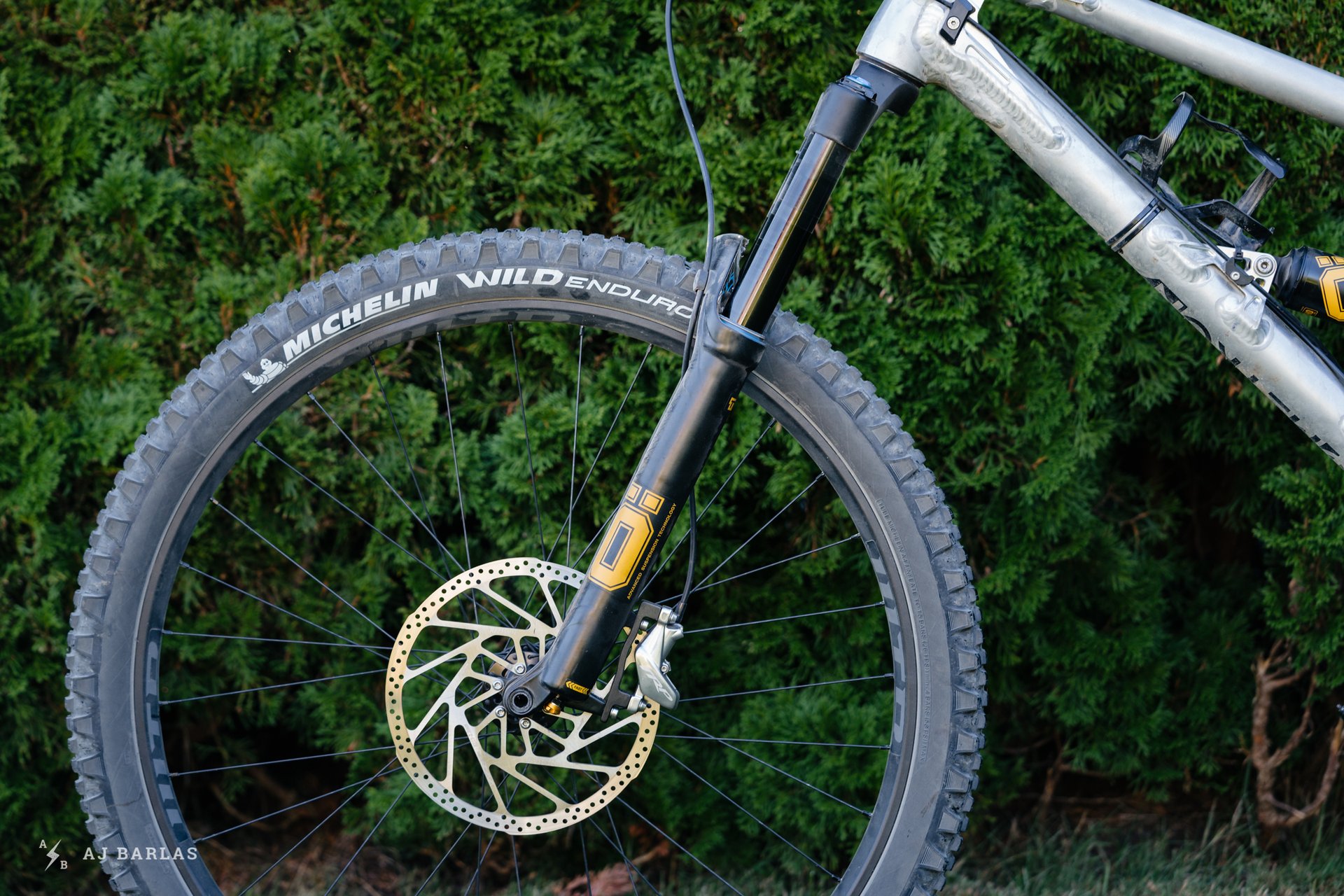
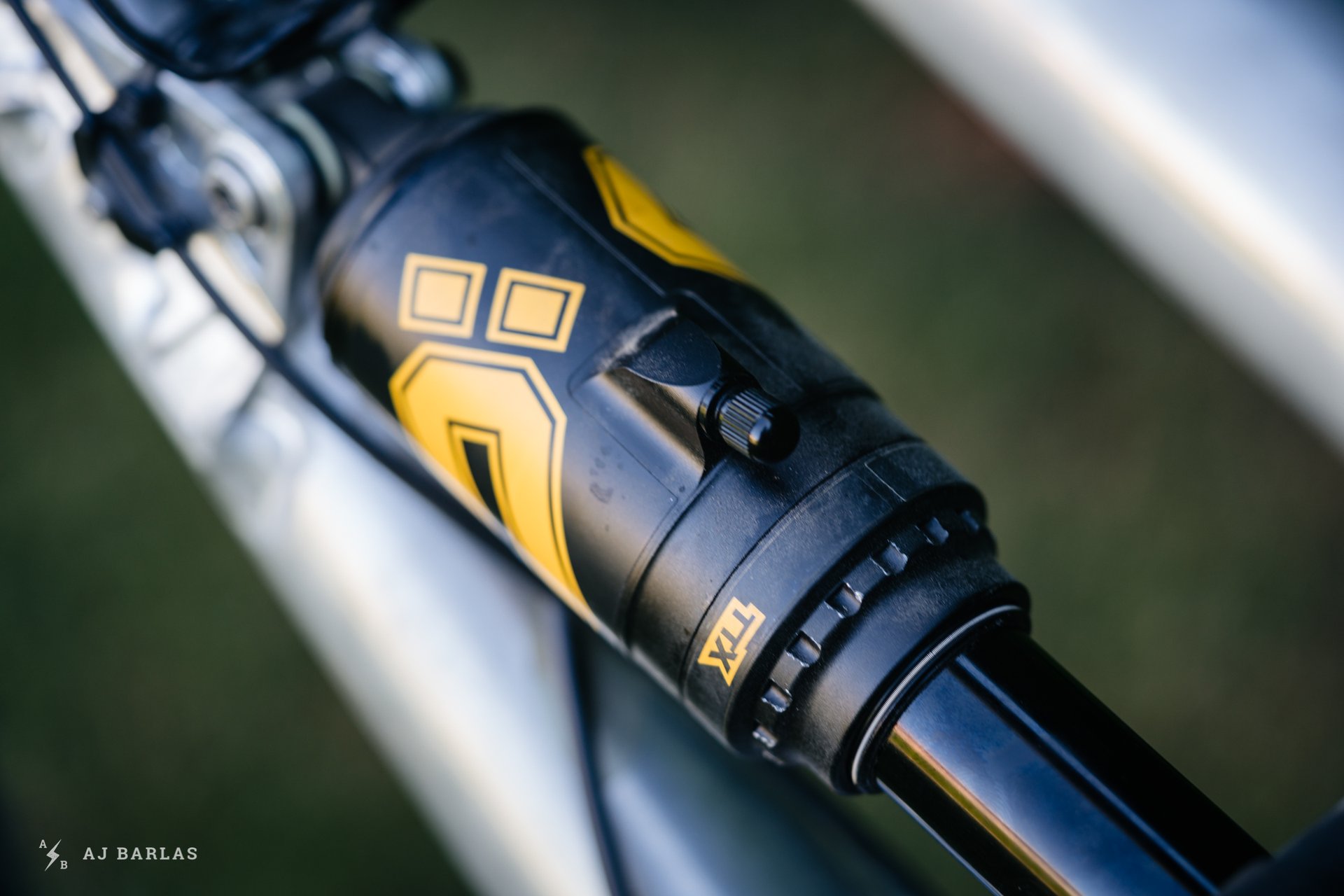
Verdict
The Öhlins RXF36 m.2 and TTX Air have performed impressively over a long period. I’ve had no issues with durability and the tune-ability of each has been excellent. There’s less room for a radically wrong setup thanks to the limited range on the adjusters, yet they provide enough for the majority of riders. Damper settings are usable throughout the range and can be set to suit using Öhlins’ large bank of configurations if there’s a need to go outside what’s provided. Grip, support, and comfort have each been great. They are priced higher than some competitors but I’ve found the damper sensational and the new air springs great too. The TTX Air spring felt more refined than the fork but each is at least as good as the competition.
Öhlins has also improved access to product knowledge and now provides service manuals for home techs. Working on the fork and shock, I’ve found each to be relatively easy and a lower leg service on the m.2 can be completed in roughly 15 minutes. There’s also an increasing number of certified technicians available to perform more involved things like a damper tune.
Riders seeking an aggressive suspension package with an unwavering ability to tackle rowdy terrain and still provide great feel in smoother situations will enjoy the latest from Öhlins.
More on the Öhlins TTX Air and RXF36 m.2 Air is available on their website.
Age: 39
Height: 191cm/6’3"
Weight: 73kg/160lbs
Ape Index: 1.037
Inseam: 32”
Trail on Repeat: Changes as often as my mood.
Current Regular: Every test product spends time on Entrail

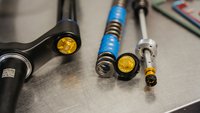
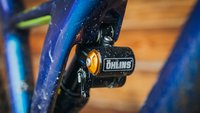





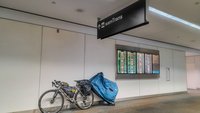

Comments
Lma
3 years, 7 months ago
Interesting comments on spherical mountings. Öhlins already has these available for the TTX coil, not the air?
Reply
WalrusRider
3 years, 7 months ago
I was thinking the same thing. I'm just waiting for my Stumpjumper Evo to destroy my DVO Topaz shock from all the side loading. Out of my riding group three of us are riding Evos and have destroyed 5 shocks over the last year and a half. If I could get one of these Öhlins with spherical eyelet bearings it sounds like it may be able to survive more than a year.
Reply
Nologo
3 years, 7 months ago
My frame was eating shocks for breakfast till I installed ttx coil. 2 summers and 1 regular service after still running smooth like a butter.
Every shock should have spherical eyelets.
Reply
AJ Barlas
3 years, 7 months ago
To my knowledge, they're not available for the TTX Air, or at least they weren't when organizing the review products. They know what bike the products are being ridden on. I'll double check to see if things have progressed though!
Reply
ackshunW
3 years, 7 months ago
I dabble in fandom of Nicolai, but I’m not expert——- even so I’m surprised you say the bike puts major side load into the shock—— really? With that giant downtube, giant welds on stout pivot mounts, and chunky rocker? I’m surprised. Do they have a reputation for eating shocks?
Reply
Cr4w
3 years, 7 months ago
Me too. This is the first review to mention that. Even with the spherical eyelet bushings?
Reply
mrbrett
3 years, 7 months ago
Spherical bearings are nothing new. They're even something seen on bikes back to a 2005 (?) Enduro, with that 5th Element shock. Also standard on any off road race shocks (like for 4x4s).
Lots of bikes side load shocks pretty substantially. Specialized is one such serial offender.
Reply
Tehllama42
3 years, 7 months ago
For all the front triangle chunkiness, there isn't as much laterally locking the seatstay-driving portions from lateral movement, and since that front triangle is definitely not going anywhere, that load ends up being borne by the shock. Just adds a lot of extra friction/stiction into the shaft elements because those seals are loaded on one side (and unloaded on the other) - they're designed to cope with it, but the actual performance of the shock basically has all the effort put into nice seals being undone by physics.
Reply
ackshunW
3 years, 7 months ago
I get that on my GG Megatrail—— where the seat stays are two separate pieces, and extend beyond the rocker link, to drive the shock. If you were to flex the rear triangle sideways, the shock eyelet would be pushed side to side too like a sideways see-saw. But to my armchair engineer eye, Nicolai has done everything right! Their rocker is a bazillion times meatier, has a giant pivot, and any forces from the seat stays have to come through those seat stay pivot bearings before getting to the shock.
Reply
Tehllama42
3 years, 7 months ago
Yeah, practically my suspicion is that Nicolai have made something that is exactly par, just that the rest of the setup is so solid and dialed that it becomes noticeable, whereas more lightly built stuff, those effects get fully masked by other flexiness or untoward behaviour.
Horst link with stiff enough seatstays to allow for meaningful side loads on the rear tires necessarily produce loads here, all one can do is reduce the length of the rocker arm that drives the shock so that the overall lateral deflection that emerges from the bearing tolerances on the other end of that rocker - this is the one area where the Nicolai frames with their very beefy arm is still limited by the need for it to move without much resistance, meaning there is some play in the bearings which translates to more lateral movement at the shock... all you can do is accept the kinematic compromises with having a smaller pivot arm for that location which usually results in less mid-stroke sensitivity, but overall slightly better side load performance (see Commencal Meta and Nukeproof Mega, or Rocky Mountain Instinct/Altitude layouts)
Reply
AJ Barlas
3 years, 7 months ago
Exactly, Tehllama42. Yes akshunW, the front triangle is solid and noticeably stiffer than the G16, but the rear and orientation of the shock are where the load comes from. It's not "major" but is there and it's partly why the spherical eyelet bearings work so well for this bike. It makes a big difference in rough off-cambers or choppy corners and compressions where the bike is being jostled about.
Cr4w, the spherical eyelet bearings remedy the issue of the suspension catching from a side load. There isn't a problem with it in place.
It's worth adding that this isn't so much a design flaw. Some movement like this is good, allowing the bike to track more comfortably than if it were stiff as a board. Nicolai/GeoMetron and EXT just worked on a way to improve the suspension with this and that was the inclusion of spherical bearings at the eyelets. Going back and forth between the two, the bearings clean up the suspension in the situations noted above but the TTX AIr does a great job of handling it with the increased overlap on the internals. If it had spherical bearings things could get quite interesting.
Reply
Tehllama42
3 years, 7 months ago
This actually surprises me slightly, given both the tendency of Specialized bikes to have a lot of shock side loading present, and Ohlins' relationship with Specialized on their high end stuff that it's not something that came promptly with the release, or even as the default configuration.
I do want to see what the TTX Coil will come with by default, as that remains arguably the more intriguing option in this space - live with the weight penalty for supreme coil F/R performance, as that basically can make a long/low/slack all-mountain bike and give it the suspension chops to be everything up to a freeride/park bike.
Reply
AJ Barlas
3 years, 7 months ago
I've fired Öhlins an email to see if it is an option for the TTX Air. It's possible it is and I wasn't made aware.
Reply
WalrusRider
3 years, 7 months ago
I'm definitely interested in hearing what they say. I'm fully expecting my current shock to show damage when I service it and these Ohlins shocks have piqued my interest.
AJ Barlas
3 years, 7 months ago
I heard back from Öhlins and they've confirmed that the TTX Air doesn't come with a spherical bearing option.
"The TTX Air uses a standard 15mm cylinder head/eyelet so too small for a bearing. TTX22m still uses a 16mm cylinder head/same as EXT."
However, they did say it would 'be very easy to do.' (with the TTX Air). Also worth noting is Öhlins mentioned the spherical eyelet bearing option on the TTX22m is an option that's not very popular.
Another snippet I found interesting was that with the move from DU bushing to bearings in a number of shock mount interfaces, they're seeing more loads being forced through the shock than before. The DU bushing interface was more forgiving in this aspect.
More problems to solve as a result of 'solutions' elsewhere.
AJ Barlas
3 years, 7 months ago
This comment has been removed.
Rob Gretchen
3 years, 7 months ago
Love this combo on my Firebird 29... top level stuff for sure... not just for racing...
Reply
momjijimike
3 years, 7 months ago
Thanks a lot for the great review!
>Öhlins has updated the stock damper tunes and now the coil fork comes with a C50 tune
Oh interesting, do you think it would be a benifit for me(about 210lbs coil-user)?
I have seen your rebound setting is faster than mine - currently 8clicks from close. So may I will try 10clicks.
For me as weekend warrior is suspension setup allways a challenge. I understand what the settings are doing and can feel the difference. But I'm not sure which setting is "better" :) Do you know what I mean?
Greetings,
Mike
Reply
AJ Barlas
3 years, 7 months ago
Hi Mike. At your weight, I don't believe you'd need to move to a lighter damper tune than the previous stock coil tune (C60). I weigh ~75kg kitted up and was able to find settings suitable though was mostly at the more open end, so there should be good range for you to achieve a solid setup. You're rebound setting also seems normal for your bigger size than me. You could try opening it up but it may get too active and fast for your other settings. The bike you ride will also influence the settings as your weight may be distributed differently than mine.
I'd say get somewhere you're happy with and unless you feel like there's room for improvement, leave it and enjoy the rides you have!
Thanks for reading and your kind words.
Edit: Mike, it's worth mentioning that the stock rebound tune (R40) has also been updated; it's now R30. I'm still using an R40 tune for the rebound and don't need more for the coil. I may have benefitted from the lighter tune with the air spring, as I did test it wide open but settled on one in.
Reply
momjijimike
3 years, 7 months ago
Super cool & thanks a lot! Best support AJ 😉
(I wrote Öhlins five messages with questions since I got the M.2 and got just ONE answer back...)
One more question - 100 hour chassis and coil spring service on an Öhlins RXF36 m.2 Coil
I can't find those things in a local bike or motobike shop. Are there some alternatives?
100 hour chassis and coil spring service on an Öhlins RXF36 m.2 Coil
01336-01 - Renep CGLP 68 Fork lube 1L
01338-22 - Renolit SI 410 M Silicone grease 225g
01337-06 - Renep CGLP 220 Air spring lube 0.6L Slickoleum or equivalent
Greetings,
Mike
Reply
AJ Barlas
3 years, 7 months ago
Hi Mike. I hit up my local distributor about them and they had it. I ordered it through my local bike shop.
Reply
fartymarty
3 years, 7 months ago
AJ - how do you rate Ohlins coil shock v EXT Storia. I figure if i'm shelling out ~£700 for an Ohlin I may as well spend the extra £250 for the EXT.
Reply
AJ Barlas
3 years, 7 months ago
Hey Marty. I haven't a fair comparison of the two. It's been a few years since I rode a TTX22m and I've never had one on the G1. The EXT on it also differs from the stock offerings people can purchase for any other bike. It has another step of customization being designed/developed around the frame and the frame somewhat around the shock. As you'll appreciate, this goes further than a typical tune configuration for a bike. I do wonder what the Öhlins with the spherical bearings would feel like though because every time I've swung a leg over a bike with a TTX22m (though pre-EXT experience) I've been super impressed. That and a press event where I spent a few runs on the previous gen. RXF36 was what originally piqued my interest in Öhlins.
Reply
fartymarty
3 years, 7 months ago
AJ - Thanks for the reply. If I were to buy an EXT I would probably get it set up by Mojo as they're only a 3 hour drive away and set up for specific bikes. What interests me is the hydraulic bottom out which would work great with the straight rate on my Murmur. An Ohlins air with spherical bearings would be very interesting.
Reply
AJ Barlas
3 years, 7 months ago
The HBO is nice for sure, and having access to the knowledge of the crew at Mojo to help with setup and fine-tuning would be great!
Reply
kram12345
3 years, 7 months ago
Aj- now that you have had your G1 for a while, do you still highly recommend it? I’m really interested in that frame and considering getting one. Since so many other companies are approaching the same geo numbers though, is there a clear advantage in your mind to spend the extra to get the G1?
Reply
AJ Barlas
3 years, 7 months ago
Hey Kram. I honestly can't imagine riding anything else yet. Size, geo, and suspension are great and for me, I haven't found another bike that fits this well, despite a number of larger brands making headway in this direction.
Reply
cedrico
3 years, 7 months ago
Where's this shock manufactured?
Reply
AJ Barlas
3 years, 7 months ago
Cedrico, all but the TTX22m are manufactured in Taiwan. Öhlins have a dedicated space there and permanent staff for improved QC from years past. There's a bit about it in the piece we did on their HQ in Sweden, though it does focus primarily on the mothership.
https://nsmb.com/articles/inside-%C3%B6hlins-swedish-headquarters/
Reply
rj
3 years, 7 months ago
I recently had a few rides with a new G1/Storia and wasnt too stoked on the base tune from Nicolai. Very slow rebound and same with the compression settings. the ride was pretty rough and I had a good ol time trying to recover over fast repeated trail chatter. So, I recently sent the shock to a tuner to add 'check valves' for better flow? and revalve it more on the lively side of the spectrum vs plow. With your storia/G1 experience do you feel this was a good move or should I have just stuck it out?
Reply
AJordan
3 years, 4 months ago
AJ- Great review! I read the original RXF 36m.2 coil review and spring swap article and had been waiting for this follow up but somehow missed it until now. I've been running the air fork on my HB130 for a year now and have always found it a bit harsh over stutter bumps and thought it was a bit over damped. Interesting that they have now given it a lighter tune as standard. I'm soon going to send it in for a full service and get a damper re-tune at the same time but I have been seriously considering going coil instead and probably keeping the C50 tune. Did you notice much of a weight penalty running coil again after air?
I also hear they have updated the airspring recently with a bigger neg chamber to make it a bit more sensitive. Do you think the bigger neg chamber could bring the ride of the air spring up to the standard of coil without any weight penalty?
Reply
AJ Barlas
3 years, 1 month ago
Hi Ajordan, apologies for the delayed response. Interesting that you found the fork harsh when encountering successive small hits with high shaft speeds. It sounds like you would be happier with the light C tune but I'd also be careful that the rebound wasn't set too slow. I can't remember noticing any negatives with the coil vs air when it comes to weight but I've also run much heavier coil forks and once used to it (a couple of rides) didn't worry about it.
I can't speak to the new air spring upgrade unfortunately but with what you're saying was updated, it's possible.
Reply
AJordan
3 years, 1 month ago
Hi AJ, cheers for the reply! In the meantime I sent the forks away to J-Tech for the new air spring and while it was with them got a custom tune on the damper. They use their own tuning settings based on rider weight, style etc. so don't know exactly what they have done or how it relates to the Ohlins tunings. Unfortunately I haven't had chance to try it out as while it was being done I managed to break my ankle and am still off the bike for a couple more weeks. Will let you know how it works out. Still intrigued to try coil though so will probably get a coil cartridge at some point to try.
Reply
AJ Barlas
3 years, 1 month ago
Oh mate, sorry to hear about the injury. Heal up well, ankles can be a bugger from what I've heard.
Intrigued to hear more about your custom tune, it sounds like it will be a winner and the guys at J-Tech know their stuff!
Reply
rkvic
2 years, 5 months ago
This comment has been removed.
rkvic
2 years, 5 months ago
Hi Aj, great follow up to the coil version review! Quite interested in pairing the coil version with an EXT Storia on my new WAO Arrival that will be here early in Dec. Also considering a Secus on the Fox 36 that is spec'ed with the bike. I read your Secus review and think both options could be awesome. Would love to hear your thoughts about pairing one of the two with a Storia on the back.
Reply
Please log in to leave a comment.